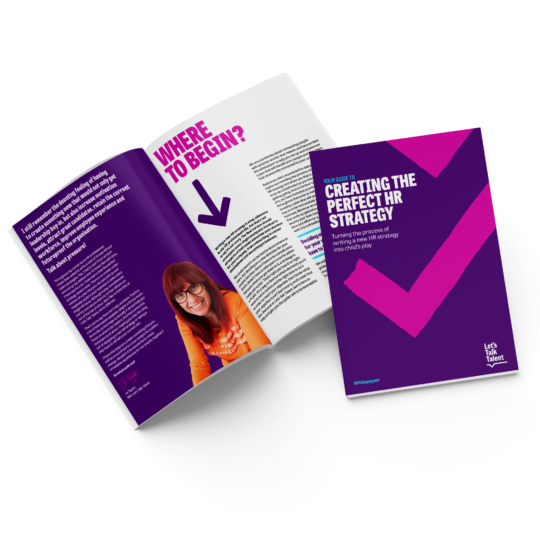How to develop a talent management strategy that supports diversity in the workplace
In 2021, many organisations will have identified diversity and inclusion (D&I) as a key focus within their overall HR strategy.
This could be due to many factors, both internal and external, highlighting the undeniable advantages of having diversity of thought around the leadership table and within the entire company. If, like them, your objective is to close an identified gender pay gap, to balance out the gender and cultural representation at senior level or simply to create an organisational culture that allows all employees to bring their whole selves to work, you are not alone in wanting to make D&I an important pillar of your HR strategy.
In fact, many businesses have realised the benefits of ensuring that they have an inclusive and diverse workforce and have proactively and successfully changed their culture. But whilst this is recognised by most as a crucial way to futureproof their business, the “how to get there” remains a bit fuzzy. After all, we can all agree that fighting unconscious bias and fostering an inclusive culture to ensure broader thinking that will benefit business performance sounds like a fantastic goal we’d all like to achieve in the short-term. But what does the reality of making it happen look like? At Let’s Talk Talent, we believe your talent management strategy can be one of the best tools in your arsenal to help you reach your diversity and inclusion objectives. Here’s how to put D&I at the core of your entire employee lifecycle, from attracting the right candidates all the way to retaining them within the business.
The diversity & inclusion consumer lens
Most organisations understand the importance of diversity and inclusion in reaching strategic and financial goals. D&I can help improve business performance as well as internal culture, and “(…) organizations have realized that a homogeneous succession pipeline poses significant risks to the bottom line.” In short, businesses need to accurately represent their community and, more importantly, their customers to survive and thrive in a competitive environment. But simply having cultural, or indeed any quotas at all, can be a blunt instrument and one that drives the wrong outcomes. For example, in recruitment, it is not enough to create an internal culture that fosters inclusion. Candidates will also need to see themselves reflected at all levels of your organisation, or they will leave to go somewhere more aligned with their core values. After all, who wants to be part of mini-me culture where everyone thinks and acts the same? So how can HR departments help generate the kind of business environment that reflects your customer base and thus promotes diversity?
What is the role of HR in implementing a diverse talent management strategy?
Whilst providing your people with a safe environment in which they can safely grow and be their full selves at work requires a firm commitment from the entire business, your HR function will play a central role in structuring this process and facilitating the implementation of a successful talent management strategy that proactively supports your wider D&I objectives. The entire employee lifecycle needs to be considered with a representative consumer lens, starting from your staff’s first ever contact with you, be it through your website or a job posting, to the day they leave your company:
Recruitment and onboarding
Go through your entire employee recruitment programme with a consumer lens on and ensure all stages of the process put diversity and inclusion at their very core. Ask yourself if any of the touchpoints from day 0, when a prospect will first hear from you, to day 90 when they will be expected to be fully settled in, could be improved and made to reflect the reality of all potential candidates. Does any of your recruitment material show unintended bias? Are your benefits packages excluding certain candidates family types? Can you review any recruitment trends over the past few years to see if key groups are underrepresented? Are you able to broaden your pool of applicants through key partnerships? Do you have internal opportunities to stop candidates from all backgrounds from hitting the glass ceiling? Are they all able to move up and across within your business successfully?
It’s also important, when filling up a job vacancy, to identify the skills, attributes and behaviours needed for the next role up to ensure prospects have the potential to step up and bring the necessary diversity of thought to the table.
Training and development
Whilst recruitment aims to attract the right candidates to your organisation, training and development ensures you retain them. It’s about giving your people the tools they need to progress and stay with you so they can contribute their diverse views and help you deliver your business strategy. This can take the shape of specific programmes, such as management training, but don’t forget that not everyone will thrive in a structured environment. Make sure you have options for those candidates who prefer to take control of their own learning path.
For one of our Fintech clients, this was manifested by identifying a gender gap at senior leadership level, creating management training programmes to fast-track the development of key high potential women and thus recognising the need to having a more balanced team at executive level in the immediate future.
Succession planning
Put simply, succession planning looks at futureproofing your organisation. It aims to provide long-term business continuity by assessing your current workforce, identifying your high potential candidates, spotting skills gaps and providing the training needed for those future rock stars to be able to step up into the next stage of their careers. In short, it’s about having a diverse pipeline of talent ready to take on additional challenges and help you deliver your business strategy.
Take time to understand who is currently on your team, where the gaps are, which groups are underrepresented and where training, external recruitment or internal mobility efforts should be focused for candidates of all background to be able to step up to the next stage of their careers.
Where should you start in reviewing your talent management strategy?
As mentioned, each touchpoint within your employee lifecycle should be reviewed with a D&I customer lens on in order to set benchmarks and inform your next steps. Whilst gathering data and analysing potential improvements for each stage, role, team and department may seem like a gargantuan task, technology can be used to facilitate the process. Artificial intelligence (AI), HR automation as well as machine-learning can provide much needed support by compiling diversity or gender pay gap metrics, predicting key turnover areas, identifying recruitment trends or gathering firsthand feedback from employees on your inclusion efforts. Auditing your talent pool with a D&I focus can highlight valuable insight into potential issues such as gender parity, recruitment bias and toxic internal culture, which can inform your next actions in terms of diversity and inclusion.
Diversity & Inclusion in Succession Planning: Conclusion
The benefits of having diversity of thought within your organisation, and particularly your senior leadership team, have been proven over and over again. And in a world where talent is in short supply, simply attracting a diverse pool of candidates isn’t enough. Retaining them is just as important.
Both your talent management and business strategies have the same goal: futureproofing your business. Aligning both to ensure a seamless experience and an organisational environment where your people feel comfortable bringing their whole selves to work and can unlock their full potential is the only way to secure the future of your company in a world where talent is your most valuable asset.
And if you’d like some guidance on how to make diversity and inclusion a key part of HR strategy, don’t hesitate to book a meeting with us, or download our HR Strategy whitepaper here.

